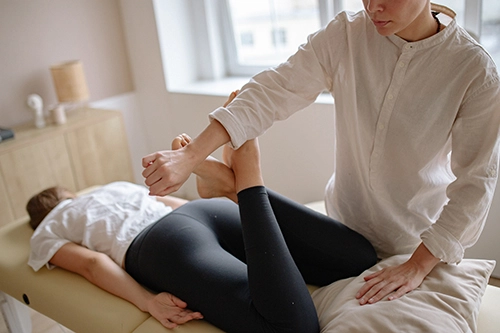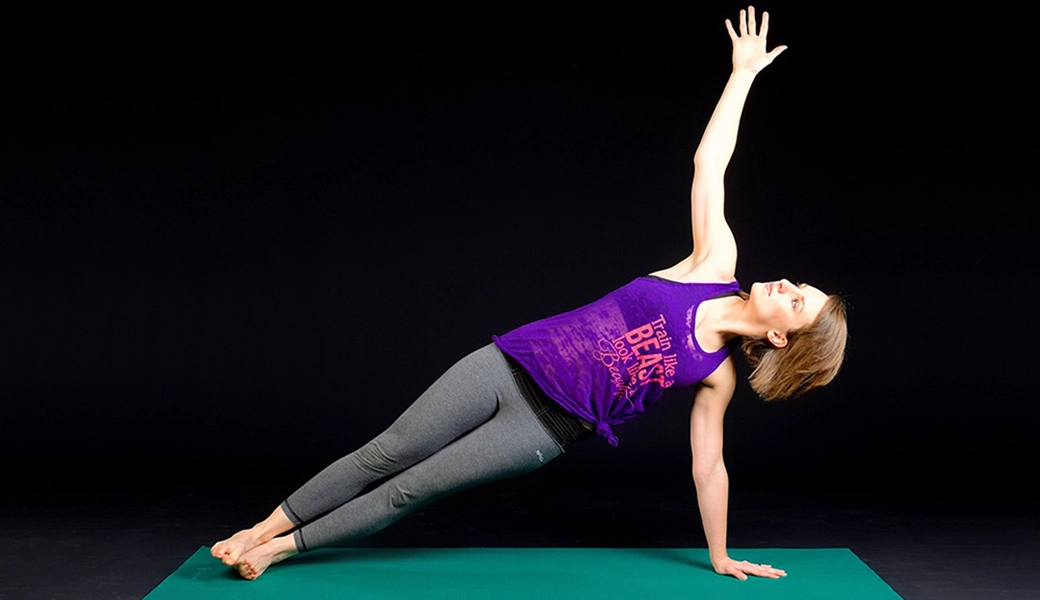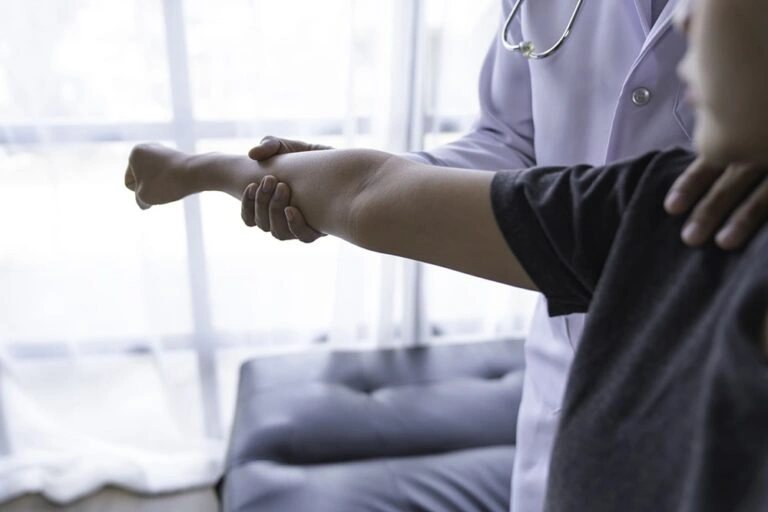Are you suffering from SI joint pain and worried about what you can and cannot do? Check out this list of exercises you should avoid.
A common treatment for SI joint pain is exercise. But not all exercises are equal. Some should be avoided. If you suffer from SI joint pain, avoid these exercises: sit-ups, crunches, planks, running, tennis, golf, leg lunges, jumping rope, and cardio machines. For more direction, consult a chiropractor or physical therapist.
As for now, let’s dig into the details of each of these a little bit more.
1. Avoid Sit Ups
If you suffer from SI joint pain, one of the first exercises you should avoid doing is the basic sit-up. When doing sit-ups you lift your torso upwards so that your chest and abdomen move towards your knees. This movement creates stress and tension in the ligaments that connect your pelvis and SI joint. This can further strain the SI joint making the pain worse.
2. Avoid Crunches
Much like the sit-up, you should do your best to avoid doing crunches when you have sacroiliac joint pain. Crunches work the abdomen and in the process, they involve lifting your chest toward your knees. Much like the sit-up, this movement can create stress and tension in the ligaments throughout the SI joint. This, in turn, can aggravate your SI joint further, increasing the levels of pain you suffer and increasing the chances of other serious developments.
3. Avoid Planks
The plank is commonly used in Yoga to develop the muscles in your shoulders, abdomen, hips, and buttocks. Again, this exercise will stress the muscles throughout the hip and pelvis by holding the same position for an extended period. Ideally, this will strengthen the ligaments and muscles around the SI joint, but if you already have issues with your SI joint, it will likely aggravate those issues instead. So, again, you are advised to avoid doing planks.
4. Avoid Running
Running is a high-impact sport for the hips. Every step taken consists of a transfer of weight from one leg and its corresponding hip, to the other leg and its corresponding hip. Every step leads to a jarring impact that strains the SI joint connections to the hip on that side of the body.
The result is, again, stress and tension in the SI joint throughout. So, if you suffer from SI joint pain, you should avoid running as an exercise. In fact, you should avoid jogging and, instead, limit yourself to walking.
5. Avoid Tennis
Tennis involves lots of running back and forth, sudden stops and changes in direction, and twisting of your pelvis and hips this way and that. It is obviously stressful to your hips, pelvis, and the ligaments throughout. So, avoid this sport, and other sports like it. This includes volleyball, racquetball, and badminton.
6. Avoid Golf
Golf is usually thought of as one of the more gentle sports. You hit the golf ball with the club and then walk a short distance and hit again. What’s hard about that? Well, the difficulty with golf and the SI joint revolves around the golf swing. The ideal golf swing involves a significant rotation of the pelvis that will aggravate an already injured SI joint. Because of this you should avoid playing golf.
7. Avoid Leg Lunges
Leg lunges should also be avoided if you suffer from SI joint pain. Leg lunges involve the shift of your weight from one leg and one side of your hip to the other. The stress and tension will naturally increase as you step into the lunge and sink your hip. If you have SI joint issues, this will likely make them worse. The connecting ligaments will be strained and the surrounding muscles will be stressed.
8. Avoid Jumping Rope
Jumping rope is another exercise you should avoid when you have SI joint pain. First, you strain the ligaments as you jump into the air, and then, they are strained even further as you fall down and land. Jumping rope involves a double high-impact landing on the ground that sends stress, tension, and shock up through the legs and into the rest of the body. Overall, it’s just bad for SI joint conditions.
9. Avoid Cardio Machines
Whether it’s a treadmill, stair climber, or other cardio machine, if you suffer from SI joint pain, you should avoid using it. The reasoning is pretty obvious. A treadmill usually consists of running or jogging in place. As a result, it bears the same warning as running for exercise does. The stair climber (and many other cardio machines), also incur similar warnings for similar reasons. The stair climber, in fact, is probably worse than simple running because it creates even more stress on the SI joint.

How To Care for SI Joint Pain?
After giving you all those things to avoid doing when you have SI joint pain, I think it worthwhile to give you some pointers on what activities you should engage in to treat and deal with your SI joint pain.
See a Chiropractor
Chiropractors are experts in the nervous and musculoskeletal system. As such, they are highly qualified to not only diagnose whatever is causing your pain (like issues in the SI Joint), but also to prescribe an overall treatment to deal with and eliminate the pain.
Many chiropractors’ offices also employ physical therapists who can not only tell you what exercises and activities you should avoid (like those above), but they can also prescribe appropriate exercises for you to do. To learn more about treating SI joint pain and the most common underlying conditions, such as ankylosing spondylitis, visit our chiropractor for spondylolisthesis.
Adjust Your Sleeping Habits
We spend roughly one-third of our lives asleep in bed. As a result, the time you spend sleeping can have a significant impact on your health. If you sleep wrong, you might just wake with a pain you’ve never had before.
If you fail to treat it properly, it may worsen over time until it becomes a serious problem, even a disability. SI joint pain is one such issue that can develop from poor sleep habits. The sleeping habits that are most likely to impact your Si joint pain include:
- Your sleep position and posture
- Your use of pillows
- Your use of the correct mattress
To learn some of the specifics of these habits, check out this post on the best sleeping position for SI joint pain.
Swimming and SI Joint Pain
Swimming is often highly recommended for individuals dealing with SI joint pain. As a low-impact exercise, swimming exerts minimal joint stress while offering a comprehensive full-body workout. The buoyancy in water supports your weight, alleviating pressure on the SI joint and making movement more manageable and less painful.
Swimming can help to strengthen the muscles surrounding the SI joint, providing more support and stability. Additionally, the resistance offered by water can enhance your flexibility and range of motion. Remember, it is always advisable to consult with a healthcare professional before starting any new exercise regimen, including swimming. If done correctly and under appropriate guidance, swimming can effectively manage and alleviate SI joint pain.
Cycling and SI Joint Pain
Cycling can be an effective exercise for those managing SI joint pain, provided it’s done correctly and carefully. Unlike high-impact activities, cycling is a low-impact exercise, which puts less strain on your joints, including the sacroiliac joint. This makes it a potentially suitable option for those seeking to maintain physical fitness while managing their SI joint discomfort. However, the benefits of cycling largely depend on maintaining correct posture throughout the activity.
Incorrect cycling posture or using a bike that isn’t correctly adjusted to your body can potentially exacerbate SI joint pain. Ensure that the bike seat and handlebars are at the appropriate height, and try to maintain a neutral spine position while cycling. It’s also advisable to start slowly and gradually increase your cycling time and intensity, as overdoing it can lead to unnecessary strain on the SI joint. As always, consult a healthcare professional before starting a new exercise regimen, including cycling. They can provide personalized advice based on your specific condition and help ensure that you are cycling in a way that won’t worsen your SI joint pain.
What does the Science say About SI Joint Pain?
Low back pain is a common type of pain for many people in the modern era. However, diagnosing the source of lower back pain can sometimes be difficult. One study by the journal “Current Orthopaedic Practice” found that 15% of patients with low back pain suffered from the SI joint (sacroiliac joint). (1)
Another study by the Wiley Online Library found a higher percentage, from 16% to 30%, to be the cause of low back pain in cases of chronic mechanical low back pain. The same study found that treating SI joint pain is most effective in a multidisciplinary approach, including exercise therapy and manipulation (chiropractic). (2)
A case study in Science Direct involved a pregnant 35-year-old woman with, among other things, a functional disturbance in the left sciatic joint. The menu of treatments used involved chiropractic spinal manipulation, exercise, soft tissue therapy, and ergonomic advice. After six weeks, her lower back pain had significantly improved, and many of her functional abilities, like walking and sitting, had also improved. (3)
Factors That Can Aggravate SI Joint Pain
While SI joint pain can stem from various causes, certain factors and behaviors can exacerbate the discomfort. Recognizing and avoiding these triggers can help manage SI joint pain effectively:
- Poor posture: Sitting or standing in an unhealthy posture for prolonged periods can put unnecessary strain on the SI joints, worsening the pain. It’s crucial to maintain good posture, especially when sitting for extended durations.
- Overuse: Engaging in strenuous or high-impact activities without proper conditioning can overwork the SI joint, escalating the pain. It’s important to balance rest and exercise.
- Stress: High-stress levels can lead to muscle tension and trigger pain flare-ups in the SI joint. Incorporating stress management techniques into your daily routine may be helpful.
- Lack of exercise: A sedentary lifestyle can lead to muscle weakness and stiffness, exacerbating SI joint pain. Regular low-impact exercises can keep the surrounding muscles strong and flexible, providing better support for the SI joint.
- Improper lifting technique: Lifting heavy objects incorrectly can strain the SI joint and exacerbate the pain. Always remember to lift with your knees and maintain a straight back, rather than bending and twisting your waist.
- Obesity: Excess body weight applies additional pressure on your SI joint, intensifying the pain. Maintaining a healthy weight can alleviate this strain.
Remember, it’s always advisable to consult with a healthcare professional for personalized advice and guidance in managing SI joint pain.
Yoga Poses to Avoid with SI Joint Pain
While yoga can offer numerous benefits, including stress relief and improved flexibility, certain poses might exacerbate SI joint pain. Thus, it’s crucial to understand which yoga poses to avoid if you’re experiencing this condition.
- Deep Twists: Poses that involve intense twisting of the spine can put excessive strain on the SI joint. Examples include Revolved Triangle Pose (Parivrtta Trikonasana) and Revolved Side Angle Pose (Parivrtta Parsvakonasana).
- Single-Leg Forward Bends: Poses that require bending forward while standing on one leg can create an imbalance in the pelvis, possibly aggravating SI joint pain. Examples include Standing Split (Urdhva Prasarita Eka Padasana) and Half Moon Pose (Ardha Chandrasana).
- Bound Angle Pose (Baddha Konasana): This pose involves bringing the feet together and letting the knees drop to the sides, creating a stretch in the inner thighs and groin. It can put pressure on the SI joints.
- Deep Hip Openers: Poses that place extreme stretch on the hips can also strain the SI joint. Examples include Pigeon Pose (Eka Pada Rajakapotasana) and Frog Pose (Mandukasana).
- Warrior I (Virabhadrasana I): This pose requires a deep lunge with the back foot at an angle, which can misalign the hips and exacerbate SI joint pain.
- Backbends: Deep backbends can destabilize the SI joint and should be avoided. These include Wheel Pose (Urdhva Dhanurasana) and Upward Bow (Urdhva Mukha Svanasana).
- Camel Pose (Ustrasana): This backbend pose can stress the lower back and SI joint too much, especially if done without proper alignment or preparation.
As always, remember that everyone’s body is unique, and what exacerbates pain for one person may not for another. It’s crucial to practice yoga mindfully and pay attention to how your body feels in each pose. If you experience pain or discomfort, gently come out of the pose. Always consult with a healthcare provider or a knowledgeable yoga instructor before starting or changing your yoga practice, especially if you’re dealing with SI joint pain.
Conclusion
If you suffer from SI joint pain, the best thing you can do is to consult a medical professional like a chiropractor or physical therapist (or even a physician). Just be aware that although exercise is a good way to treat SI joint pain, there are some fairly common exercises you really must avoid. With appropriate guidance, though, you’ll be on the road to recovery.









